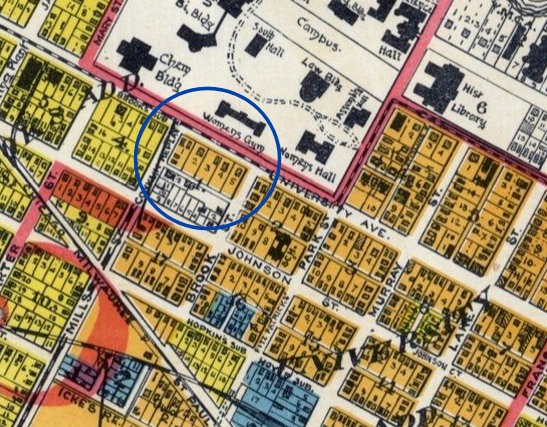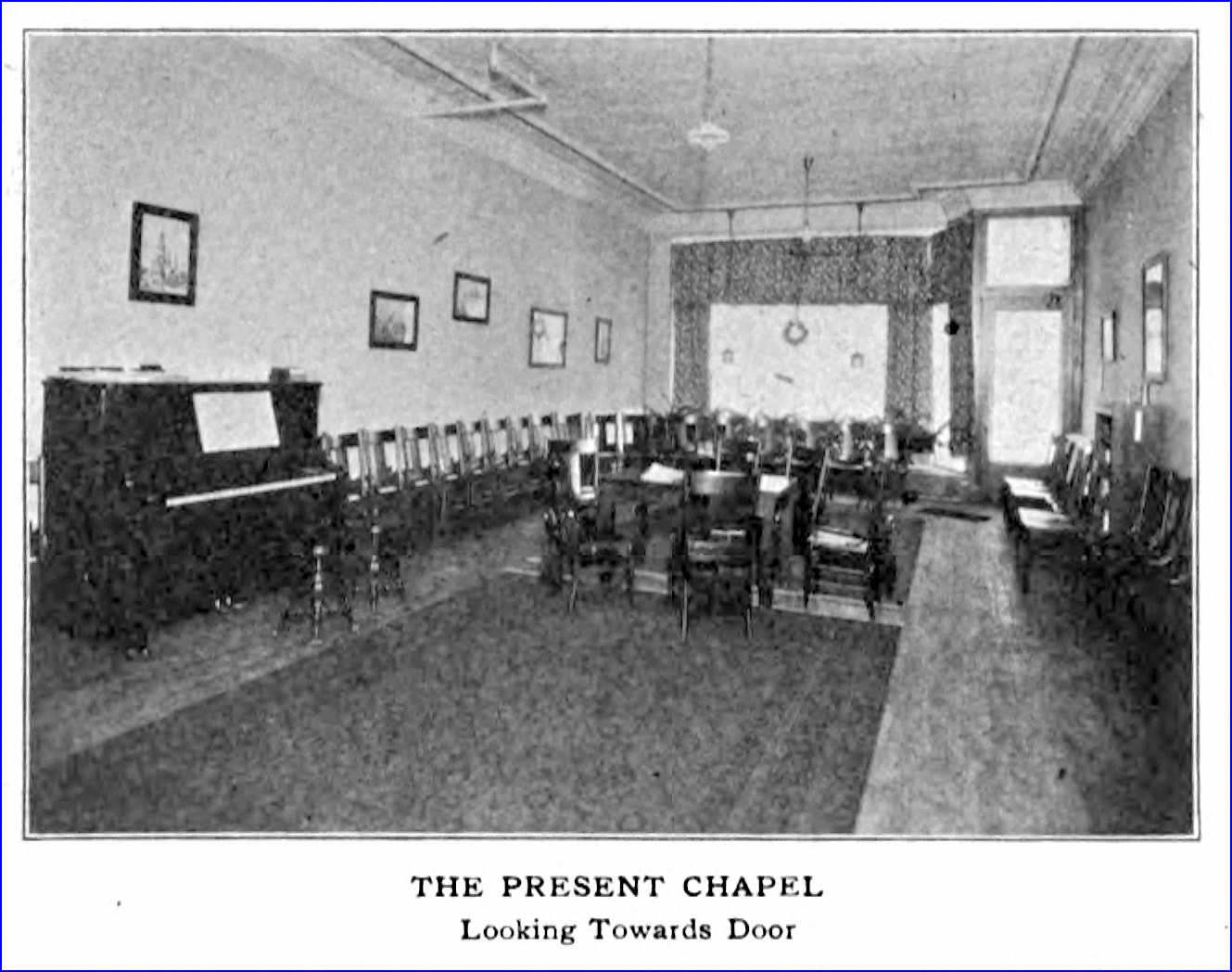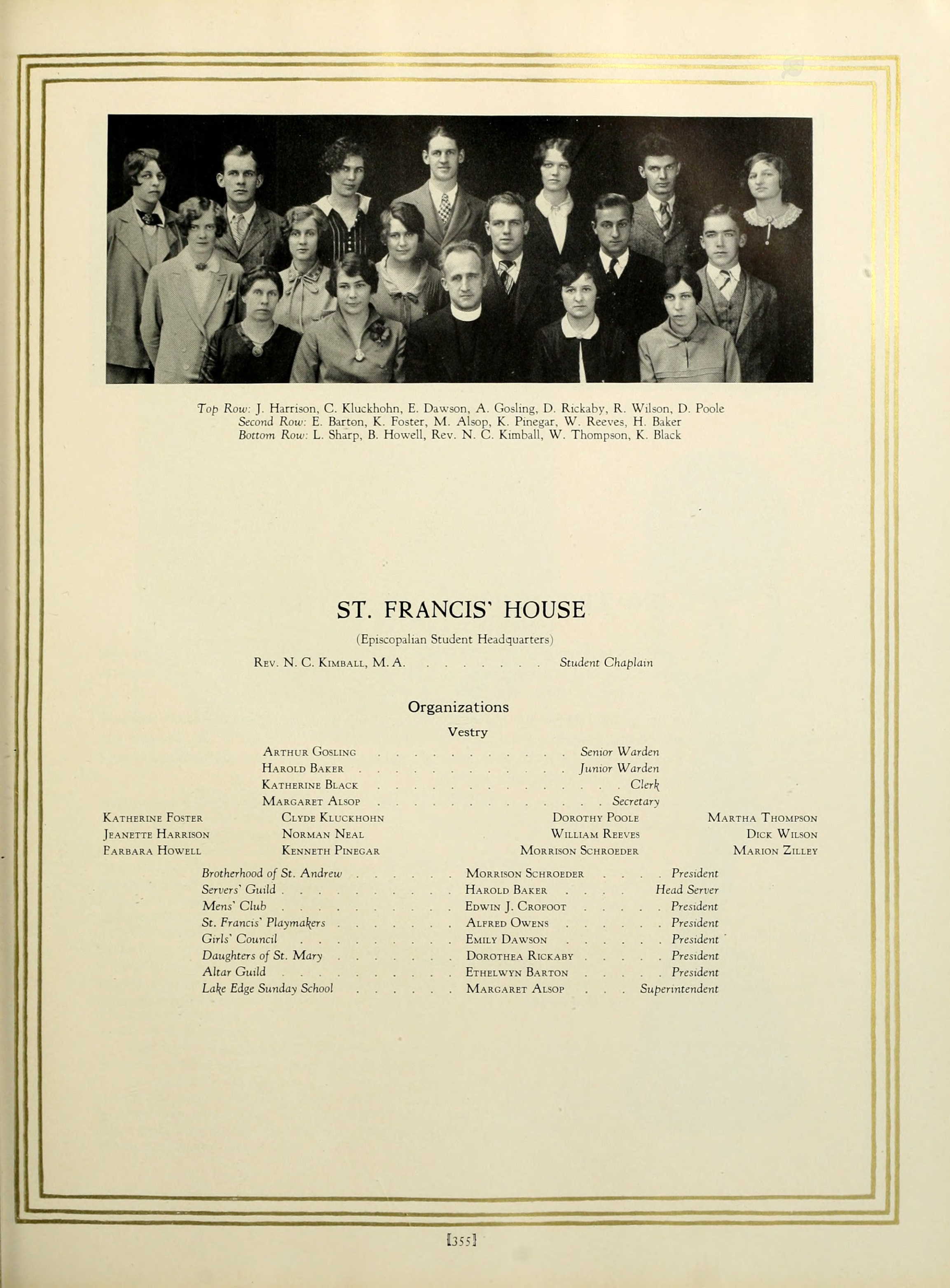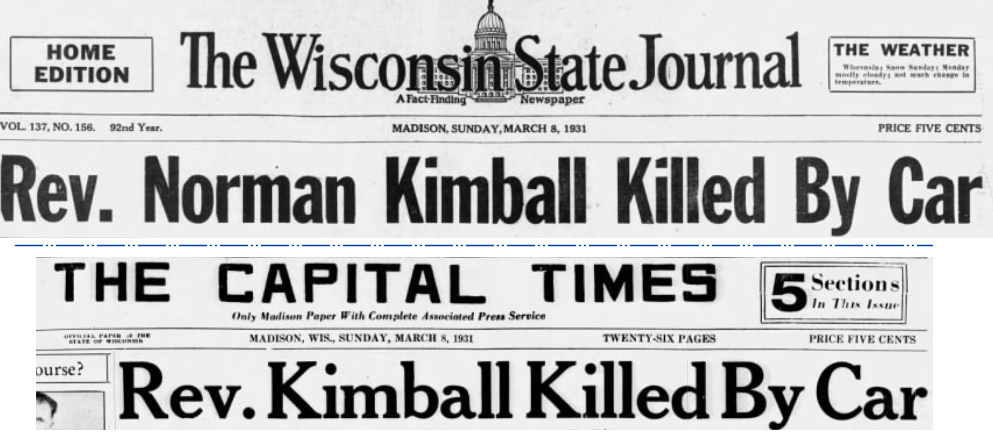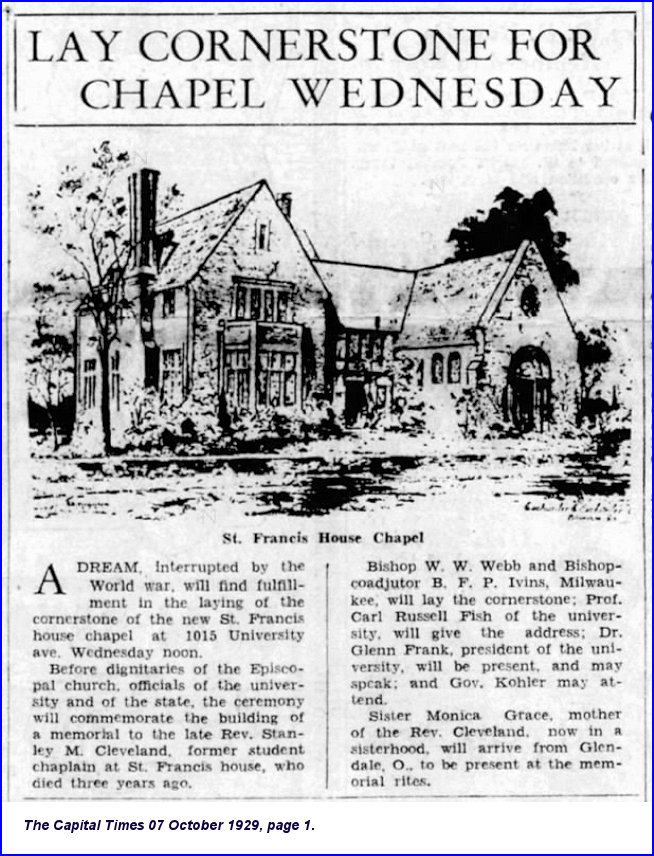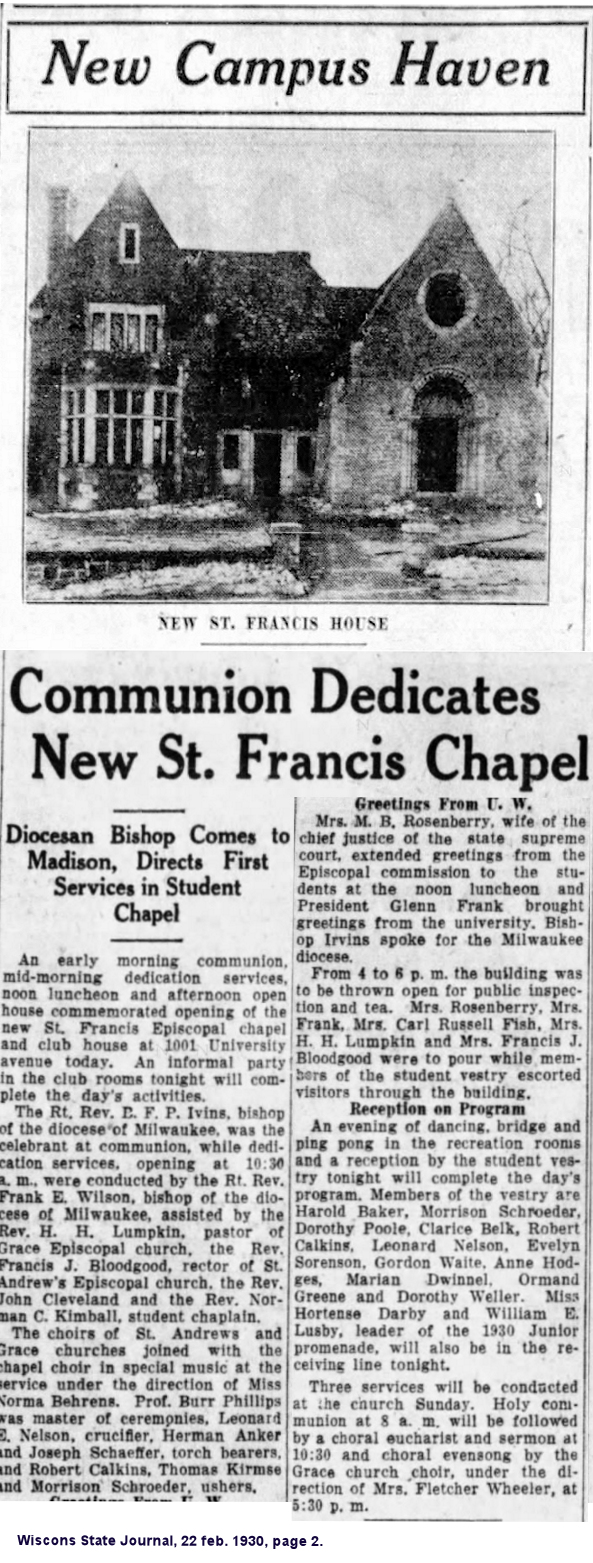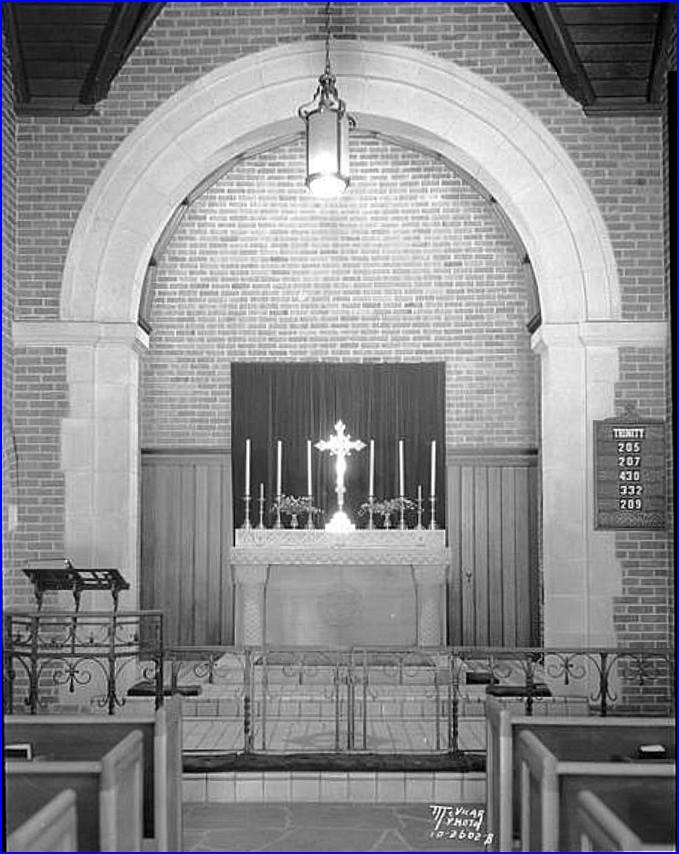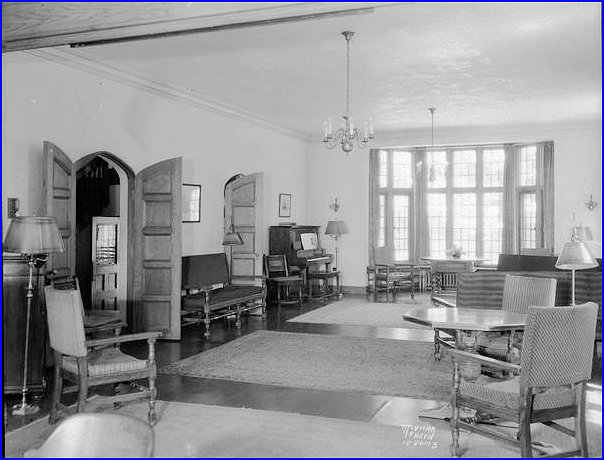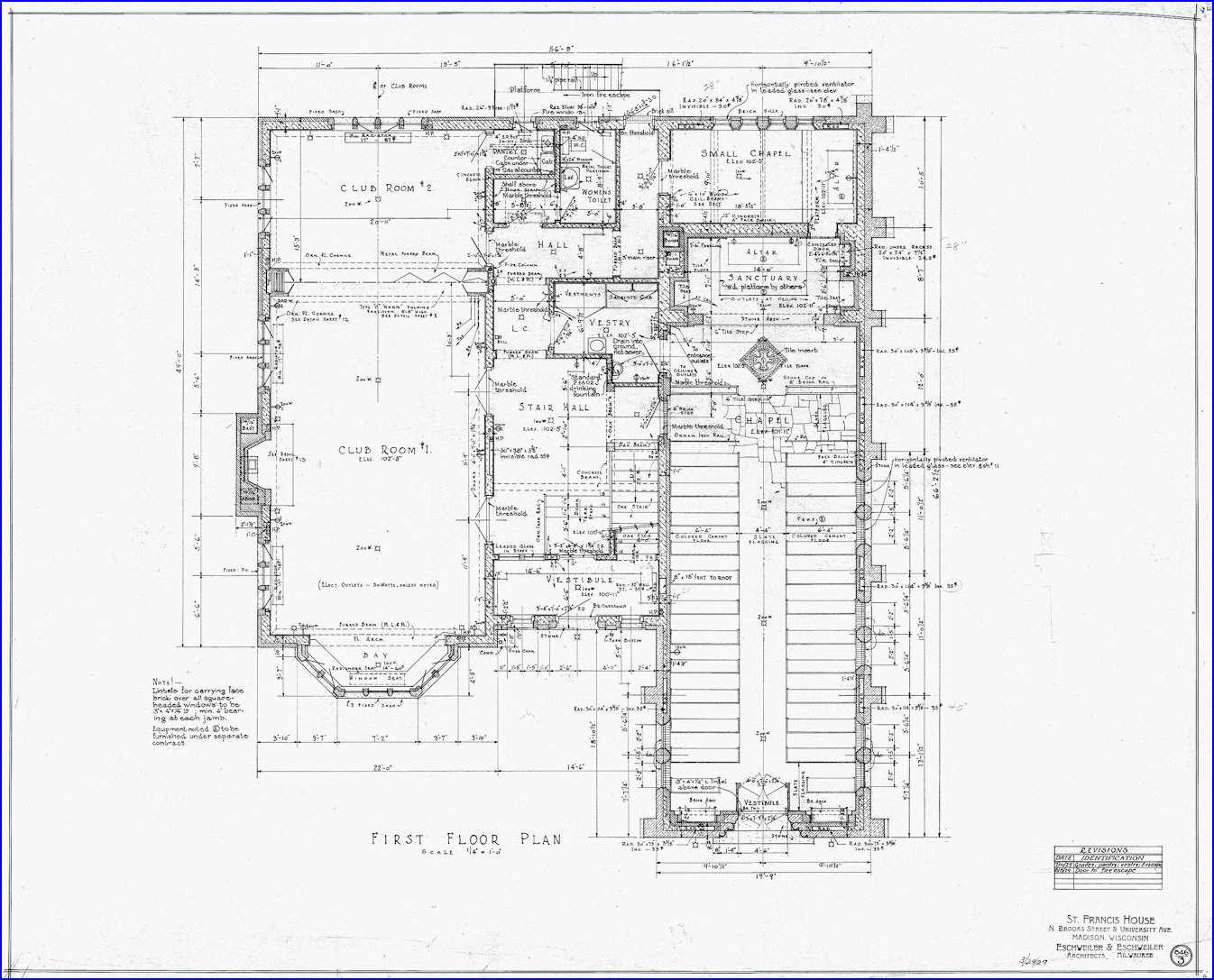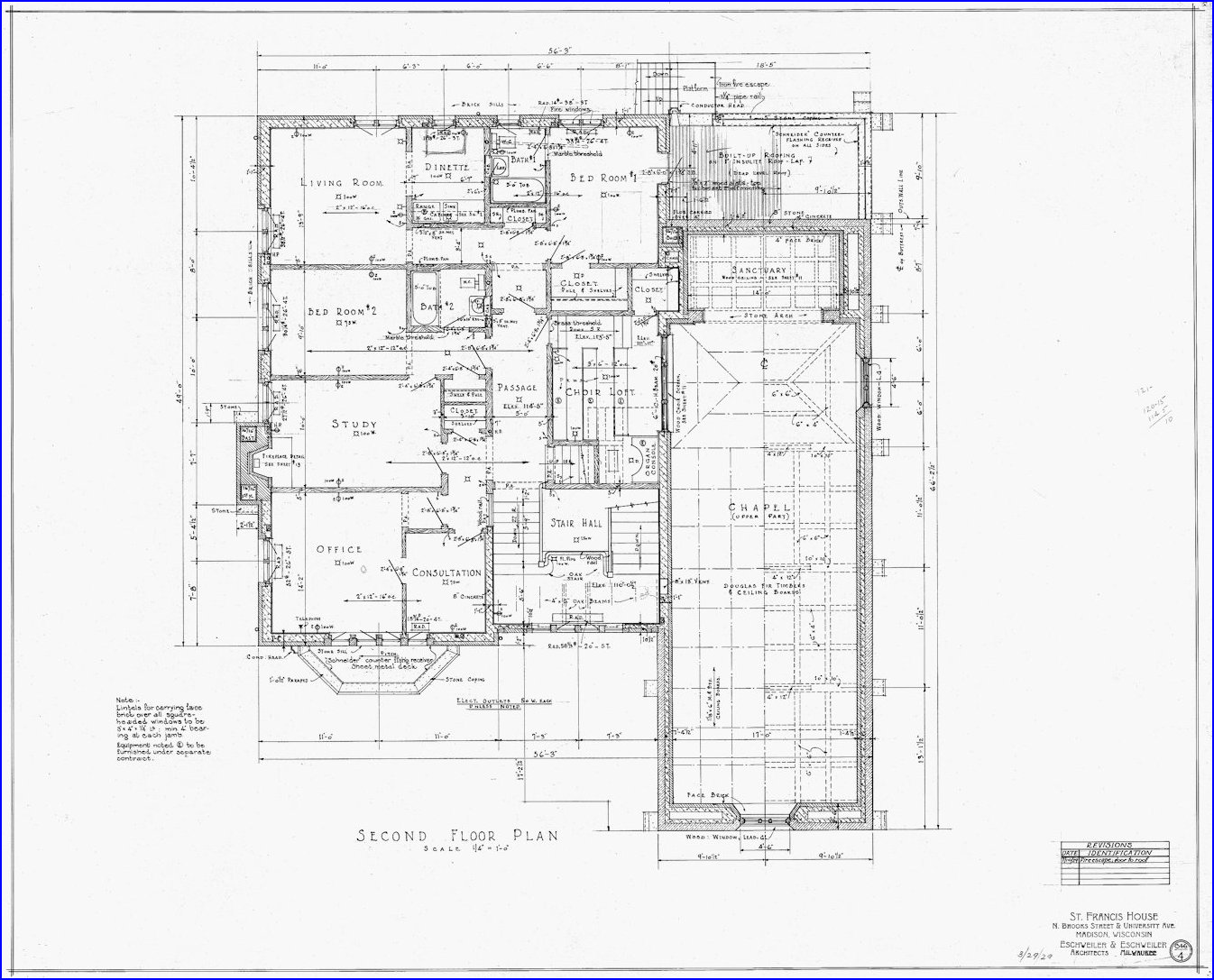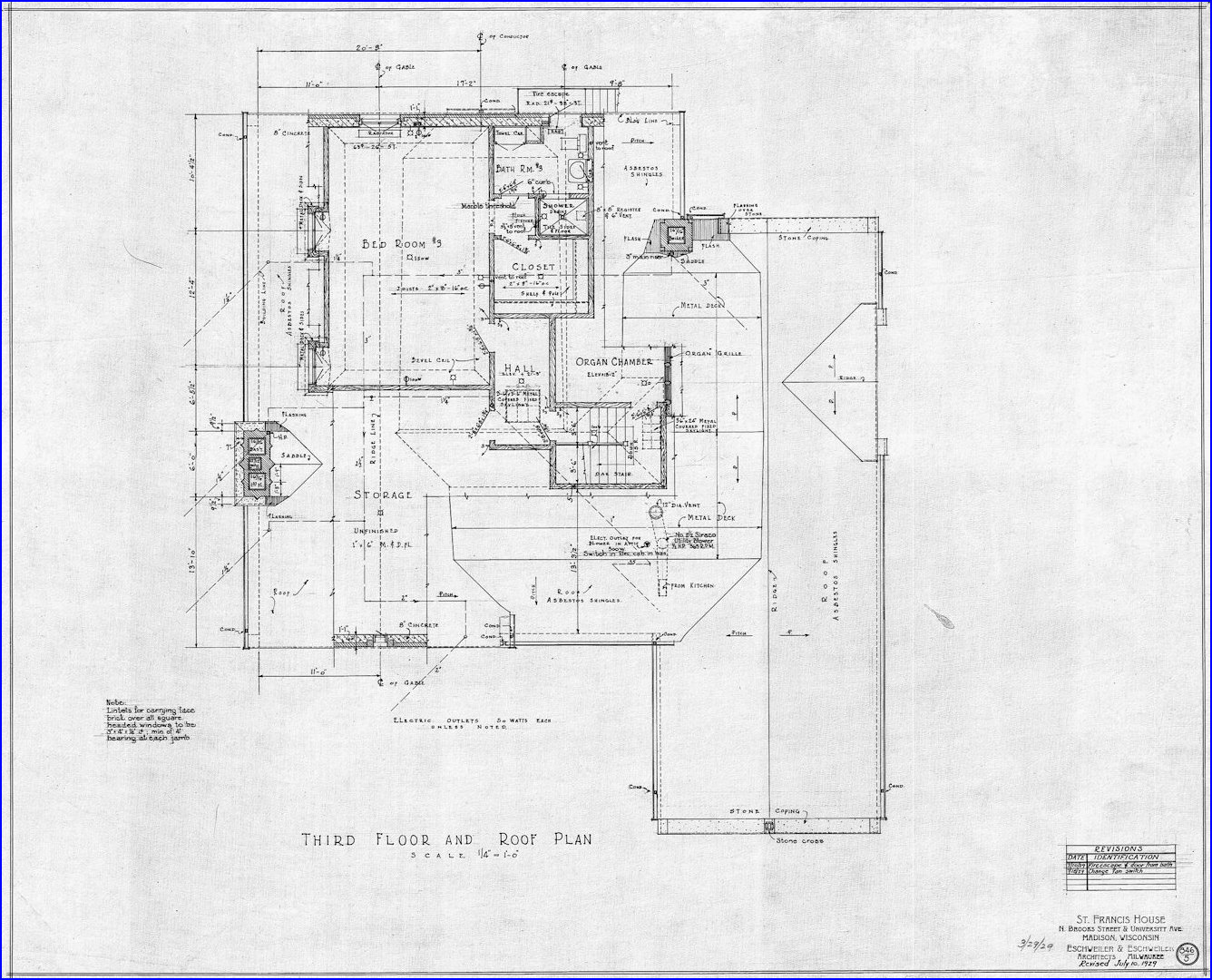St. Francis House
Madison, Wisconsin
Part One
The First Fifty Years
Begun as a community of Episcopal Church students in 1915, and now over one hundred years old, this page tells its story through the first fifty years with short biographies of the principal chaplains.
This History is an independent research project not affiliated with St. Francis House.
For the second part, 1964 to the present, click here.
Note: links to newspapers.com may require a subscription.
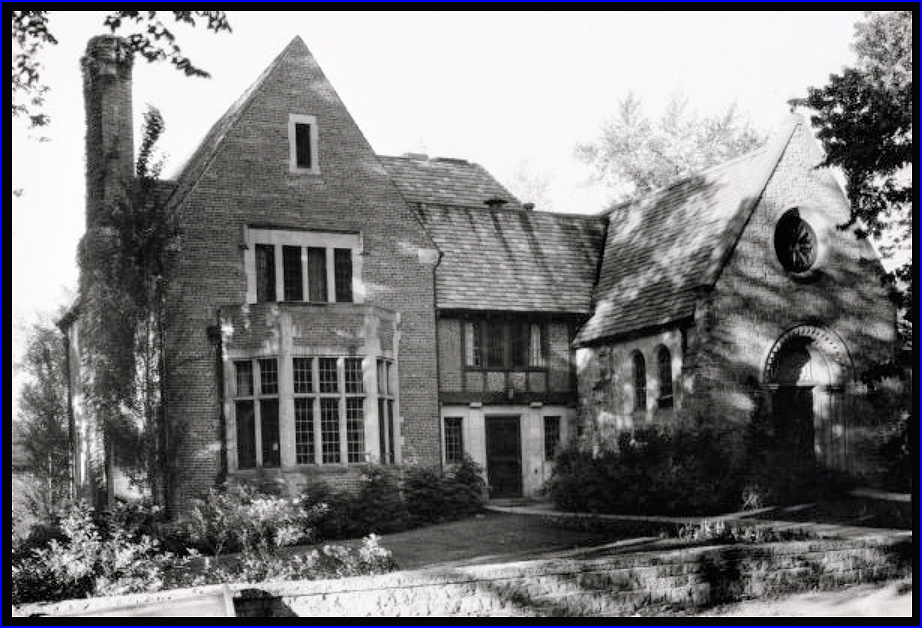
1934 Exterior picture from WHS.
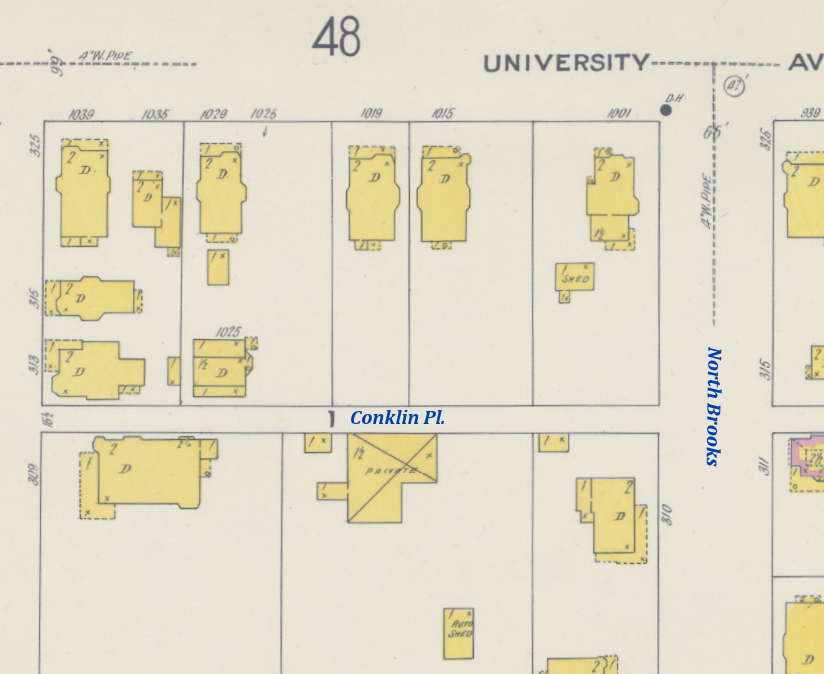
1908 Sanborn Fire Insurance map of the block showing the three houses. Sanborn maps were not all that good when it came to lot lines.
On April 3, 1918 a deed was recorded in purchase of lots five, four and the east half of lot three of Block 1 in University Additions, the corner of University Ave and Brooks Street in Madison. Three houses were on the 182 by 160-foot parcel and it sold for $46,000. (Footnote:
Portage, Wisconsin Daily Register, 18 May, 1920, page 3 – article about the Rev. Dawson leaving Portage for the chaplaincy of the St. Francis’ Society. Not confirmed by deeds or purchase agreements, but given that Dawson was likely largely responsible for engineering the purchase it is likely accurate.
) (Footnote:
WSJ 10 March 1922, page 11. Col 4. - A lengthy description of the property in a petition of the University Commission of the Church in Wisconsin to the Mayor, etc., of Madison. Maybe the best description of the houses, etc. on the lots mentions that one of the houses has been occupied by Cleveland and an altar installed on the second floor. https://www.newspapers.com/image/401352660/
) It would be another ten years before a chapel and center for Episcopal Church students on the campus of the University of Wisconsin would be realized on that land. Reflecting on the purchase, Bishop Webb wrote in the February, 1919 Church Times that “A large lot on University avenue came unexpectedly on the market. It is an ideal lot.” (Footnote:
“Church Work at the University of Wisconsin”, The Church Times, February, 1919, page 470. (The Church Times was the “Official Organ of the Diocese of Milwaukee” published from 1890 to 1958. Most issues from 1897 to 1926 are in the public domain and accessible at HathiTrust.org: https://catalog.hathitrust.org/Record/005947607
HathiTrust also has the 1947 History of the Diocese by Harold Ezra Wagner online in full view (https://catalog.hathitrust.org/Record/005947915) which also has some pages on St. Francis House. Hereafter “CT”.
)
The History
But that was not the beginning. In May of 1915, the Rev. Morton C. Stone accepted a call to be rector at St. Andrew’s on Regent Street and serve as chaplain to students at the University. To that end he established rooms with a chapel and office in the triangular building, the Eleanor Apartments, on the corner of West Gilman, Francis, and University Ave. (Footnote: CT, September, 1916, page one and following. https://hdl.handle.net/2027/wu.89064896616?urlappend=%3Bseq=573 )
Chapel at 458 W. Gilman - Corner of University, Gilman and Francis Street - in The Eleanor Apartments.
In the spring of 1916 he resigned his rectorship at St. Andrew’s to devote his time fully to the chaplaincy. In May of that year an important and exciting meeting led by Mr. William Dawson, a former Methodist minister, Rev. Stone, and Bishop Webb of the Diocese, among others, took place at which the “University Commission of the Church in Wisconsin” was formed to raise money to purchase land and build a permanent chapel. (Footnote: CT, June 1916. https://hdl.handle.net/2027/wu.89064896616?urlappend=%3Bseq=521 ) World War I took its toll, the chapel was closed in 1918 and Rev. Stone moved on to Racine to do educational work. (Footnote: CT, June 1918, page 347. The bishop wrote, “I am very sorry to have to close the chapel at the present time, but it seems wisest to so on account of war conditions.” ) The “St. Francis’ Society”, as it was called, was not dead however, as Bishop Webb reported in the February, 1919 Church Times meeting with a number of students at Grace Church.
The Rev. Dawson resigned his post in Portage, Wisconsin in the summer of 1920 to come to Madison and took up residence in the house on the corner, 1001 University Ave. In 1921 the work among the students saw a spirited revival with the appointment of the Rev. Stanley Matthews Cleveland as a full-time chaplain. (Footnote: “Student Work At Madison”, The Church Times, September, 1921, page 386 has perhaps the most complete biography of Rev. Cleveland taken from The Living Church. https://hdl.handle.net/2027/wu.89064896632?urlappend=%3Bseq=396 - The original biography with photo from The Living Church is at https://www.google.com/books/edition/The_Living_Church/uuhqiO80aekC?hl=en&gbpv=1&pg=PA707 ) The Rev. Cleveland wasted little time, opening the house at 1015 University Ave in September as the “St. Francis Club House,” the home of the St. Francis’ Society. In the July, 1922 issue of The Church Times he wrote in his extensive Annual Report that “The work among students at the University of Wisconsin during the academic year 1921-1922 has been largely experimental. It seems however, to have resulted in a stable organization, and, I think, can be fairly said, now to be on its feet.” St. Francis Clubhouse saw an average of 243 students a month drop in to the club house for recreation, rest, reading and so forth. The little chapel in the house would only accommodate about eighteen people so little attempt was made to have any Sunday services, those were conducted at Grace Church. (Footnote: "Annual Report of the Student Chaplain at Madison" - This extensive report covers several pages in The Church Times: https://hdl.handle.net/2027/wu.89064896632?urlappend=%3Bseq=731 )
The Rev. Cleveland’s tenure as chaplain was central to the establishment of the St. Francis’ community, but it was cut short by an illness that forced him to resign at the end of 1924 and return to his Ohio birthplace where he died in 1926 at the very young age of 37. He was replaced by the Rev. Norman Captive Kimball, who had had plans to go to New York City, but accepted the job for four or five months. (Footnote: The Capital Times, 31 Dec 1924, page one. https://www.newspapers.com/image/517927084 ) “Four or five months” was not to be as he stayed on until 1931 when he was tragically killed by a car in March of 1931. (Footnote: His death on March 7th was headline news in both Madison papers. He had been travelling to Milwaukee in a blizzard when his car stalled. Crossing the road to use a telephone, he was struck by a car driven by a man who was temporarily blinded by the blowing snow. Many tributes and memorials followed in the weeks following. )
It was Kimball, however, who saw and ushered in the building of the present St. Francis House.
The first announcement in the Madison newspapers of the new St. Francis House appeared in February of 1929 when the Capital Times reported that “Funds are now available and work will probably be started this summer.” (Footnote: "Erection of St. Francis House Starts In Summer", 13 Feb 1929 Capital Times https://www.newspapers.com/image/517899874/ ) The paper reported that the estimated cost would be about $125,000 but final action on the construction plans will not be taken until the recovery from illness of Assistant Bishop Benjamin Ivins. Plans dated March, 1929 were drawn by the Milwaukee firm of Eschweiler and Eschweiler; requests for proposals to sub-contractors were eminent. Indeed, sub-contracts were let late June by the general contractor, John H. Findorff and Son of Madison, today still a major builder in Madison. Click here to see the sub-contractors article in the paper. Ground was broken July 1, 1929 and the cornerstone was laid in October of that year.
Original Floor Plans courtesy of
Wisconsin Architectural Archive / Milwaukee Public Library
When it happened is unknown, but by at least 1960 the "Storage" spaces in the basement and the third floor had been converted to rooms which housed six "houseboys" upstairs and six downstairs.
Whether installed for the opening or within the year, an organ by the prolific organ building company of M.P. Möller of Hagerstown, Maryland was installed in a loft on the second floor off the hallway to the apartment. (See the second-floor plan above.) Bill Mueller, the organist from 1963 until 1985, described the organ which accompanied services for over 30 years:
“Its stop list was reflective of the tonal design of the early 20th century. That design was characterized by pipes voiced on the mellow and warm side. There was very little upper work to give brilliance to the overall sound. It essentially contained 9 ranks of pipes which were installed in the ceiling of the chapel to the upper left of the altar. The console and choir were in a recessed area on the second floor just under the pipe chamber.” (Footnote: Bill Mueller, email 8/29/2021. The organ, with some errors in detail, is listed in the Organ Historical Society’s organ database: https://pipeorgandatabase.org/organ/32143 )
The organ was revised and rebuilt with the 1964 addition and lost in the 2012 move. There are pictures of the organ and description of revisions in the second part of this history.
Work proceeded quickly through the winter, the House was dedicated and opened on February 22, 1930. Activity at the House was intense in the following years. With the Rev. Kimball’s tragic death a year after the House dedication the interim chaplains were replaced shortly by the Rev. Alden Kelley in June of 1931 who served for the next eight years. Announcements of tea-dances, guest speakers and other activities at the House fill the newspapers. In 1932 the “St. Francis Playmakers” participated in a church drama tournament, losing unfortunately to the players from the First Congregational church.
When the Rev. Kelley left in 1939, he was replaced by a man who after three years would leave for Puerto Rico to become, in 1943, the bishop co-adjutor there, the Rev. Charles Boynton. These war years were disruptive and while ministering to the student population was filled at times by interim and visiting pastors, the Rev. Gordon Gillett took the reigns for two years in 1942, leaving in 1944 to be replaced for just about 8 months by the Rev. Daniel Corrigan.
 A certain amount of stability to the chaplaincy returned with the appointment of the Rev. Carroll Simcox in March of 1945. He stayed until March of 1949.
Much more stability reigned once Father Gerald White took over in November of 1949. Mrs. Yvonne Otto, the widow of a former rector of the parish in Oshkosh who died in 1946, moved into the apartment on the second floor to become housemother and hostess in March of 1951, retiring at the end of the 1964-65 academic year. (Footnote:
Mrs. Otto's appointment: Neenah, Wisconsin News-Record, March 20, 1951, page 3. “A letter was received from St. Francis house, Madison, telling of the appointment of Mrs. William Otto, wife of a former rector of the Episcopal church, Oshkosh, had been name dean (sic) of St. Francis house.”
) Click for Mrs. Otto's Find-a-Grave memorial.
A certain amount of stability to the chaplaincy returned with the appointment of the Rev. Carroll Simcox in March of 1945. He stayed until March of 1949.
Much more stability reigned once Father Gerald White took over in November of 1949. Mrs. Yvonne Otto, the widow of a former rector of the parish in Oshkosh who died in 1946, moved into the apartment on the second floor to become housemother and hostess in March of 1951, retiring at the end of the 1964-65 academic year. (Footnote:
Mrs. Otto's appointment: Neenah, Wisconsin News-Record, March 20, 1951, page 3. “A letter was received from St. Francis house, Madison, telling of the appointment of Mrs. William Otto, wife of a former rector of the Episcopal church, Oshkosh, had been name dean (sic) of St. Francis house.”
) Click for Mrs. Otto's Find-a-Grave memorial.
The combination of Fr. White and Mrs. Otto in 1950s and into the 60s saw a rather tranquil “English” flavor to the St. Francis House community. Regular services, cost dinners on Tuesdays and Thursdays, confirmation classes, evensong daily at 5 p.m., and afternoon tea at 4 p.m. instituted by Fr. White were the hallmarks of life at the House. (Footnote: WSJ, Service listings, 14 Jan 1950, page 8. ) As were annual fund-raising bridge-teas involving women of the Episcopal parishes of Madison.
Change was in the wind with the coming of the 1960s. In October of 1961 the Diocese authorized a $600,000 development fund that earmarked $150,000 for the construction of a new chapel attached to the existing House. (Footnote: "Student Center of Episcopalians Plans New Chapel," WSJ, 7 April 1962, page 24. https://www.newspapers.com/image/401197143/ )

Fr. White retired effective June 30, 1964 and contracts were let for the new addition at the same time. Fr. Abel was appointed the new chaplain, the announcement coming on the same page of the Wisconsin State Journal as the sketch of the new chapel. (Footnote: 1) Fr. White’s retirement: WSJ, 13 June 1964, page 8; 2) Contracts let: WSJ, 2 July 1964, page 8. ) Construction of the new chapel, which featured not only a dramatic mosaic illustrating the Seraphic Cross of St. Francis made in Germany, but classrooms below, proceeded quickly; the first service was held in the new chapel on December 5th, albeit without the pews, the mosaic, or the organ. (Footnote: WSJ, 5 December, 1964, page 4. The article features a picture of Fr. Abel standing in the chapel with the mosaic wall behind him and mentions that the design was by the firm of William Horne and Associates of Madison. The mosaic was installed the next year as its shipment from Germany was held up by a dock strike. )
The Chaplains
Ten men served as the primary chaplains of St. Francis House in its first fifty years. Most all came to Madison as fairly young men, but not as their first pastorate. Two went on to become bishops. Several have not always accurate Wikipedia articles (Boynton, Corrigan, Simcox.) These are brief biographies along with pictures of the men gleaned from the newspaper articles reflecting how they appeared when accepting the post. All of them have Find-a-Grave memorials.
I have not footnoted every fact. Sources were gleaned from newspaper articles, obituaries, the Episcopalarchives.org, ancestry.com sources, The Church Times – the official paper of the Diocese of Milwaukee issues from 1913-1926, and Wikipedia articles. Anyone wanting specific references should contact me at the email address at the end. Steve Spicer
The Rev. Morton Charnley Stone (1886-1973);
Chaplain 1915-1918
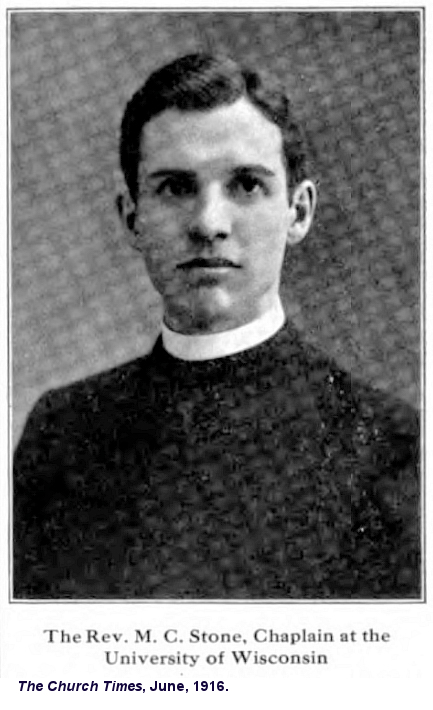
Born in La Grange, Illinois the son of his namesake, rector of the Episcopal church there. By age 14 the family had moved to Taunton, Massachusetts. Educated at Yale and the General Theological Seminary he served briefly as curate at the Church of St. Mary the Virgin in New York City. At age 29, in 1915, he accepted the call to St. Andrew’s in Madison and year later resigned to become full time chaplain to the University students as well as to get married to Miss Gwynneth Burn in New York with whom he had two children. Moving on in 1918 to Chicago, then Champaign, Illinois and then to Westchester County in New York, he died in there 1973, his wife the following year. I’ve not been able to find an obituary which might give more details of his life.

The Rev. William Dawson (1873-1951);
Archdeacon 1920-1951
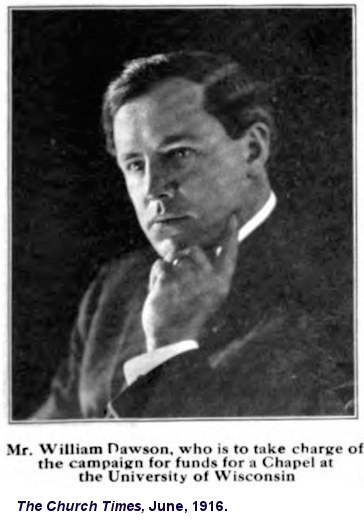
For a year an interim chaplain, he was a major factor in the eventual building of St. Francis House. Born in England he was a pastor in the Methodist church in Hebron, Wisconsin and Neenah-Menasha for a number of years until 1910. Leaving that career, he went to Madison to work as secretary of the Highway Commission and to study as well for Holy Orders. While still “Mr. Dawson,” in June of 1916 he was named in a joint action by committees in the Dioceses of Fond du Lac and Milwaukee to head the “University Commission of the Church in Wisconsin” to raise funds to build a chapel on the campus. Ordained, he served for two years in Portage before coming to Madison in 1920 to live in the frame house at 1001 University Ave with his wife and two sons when also he was appointed archdeacon. He ministered to students as chaplain for a year, lived at 1001 University for five years before moving to Milwaukee to become Executive Secretary of the Diocese, editor of The Church Times and other sundry duties until retiring in 1949, dying two years later. He and his wife Grace, née Rehn, had three children.

Rev. Stanley Matthews Cleveland (1889-1926);
Chaplain 1921-1924
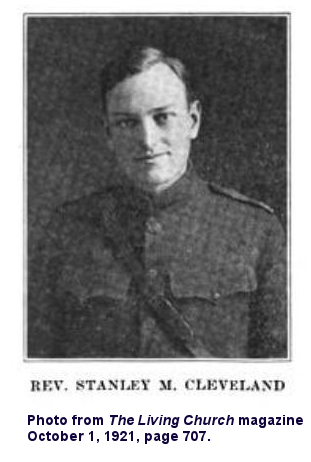
Born in Glendale, Ohio on April Fools’ Day, 1889, Stanley attended the University of Virginia and the General Theological Seminary in New York. He married Marian Van Buren in Washington, D.C. in 1915 with whom he had four children. “While rector of a small parish in southern Ohio he was chaplain for the Bethany Home for girls and boys and of the Cincinnati Opportunity Farm for delinquent girls. At our entrance into the war, he was one of first twenty-five men to sail from America for service with the A.E.F.-Y.M.C.A. As educational Secretary at St. Nazaire, Camp Secretary with the 5th U.S. Marines. Area Secretary of the Dijon Area, and at the front with the 103rd F.A., 26th Division, at Soissons and near Toul, he served one year with the Y.M.C.A. overseas. Receiving then his appointment as Chaplain, First Lieutenant in the Regular Army, he served with the 307th Infantry, 77th Division, the New York National Army Division, in the Argonne-Meuse offensive. After the Armistice and three months detached duty with a base hospital, he returned to America to become assistant at Trinity Church, Princeton, New Jersey.” (The Church Times, September, 1921, page 386)
Accepting a call in September of 1921 by the Diocese of Milwaukee to become chaplain to the Episcopal students at the University of Wisconsin he was instrumental in creating the St. Francis community of students. In a tribute to him by a former classmate in The Church Times, it was written, “Equipped with only a rectory and the St. Francis Club House (a converted residence with a tiny chapel), Mr. Cleveland succeeded in making the club house the center of the social life of the Episcopal Students, but what is of greater importance is that he made it the center of their devotional life as well.”
Sadly, his life was cut short by illness, he returned to Ohio in January of 1925 and died in Cincinnati in September of 1926 at the age of 37, leaving his widow and four children, his mother, two sisters, one of which would marry the rector of St. Andrew’s, the Rev. Francis Bloodgood, and two brothers.

The Rev. Norman Captive Kimball (1886-1931);
Chaplain 1925-1931
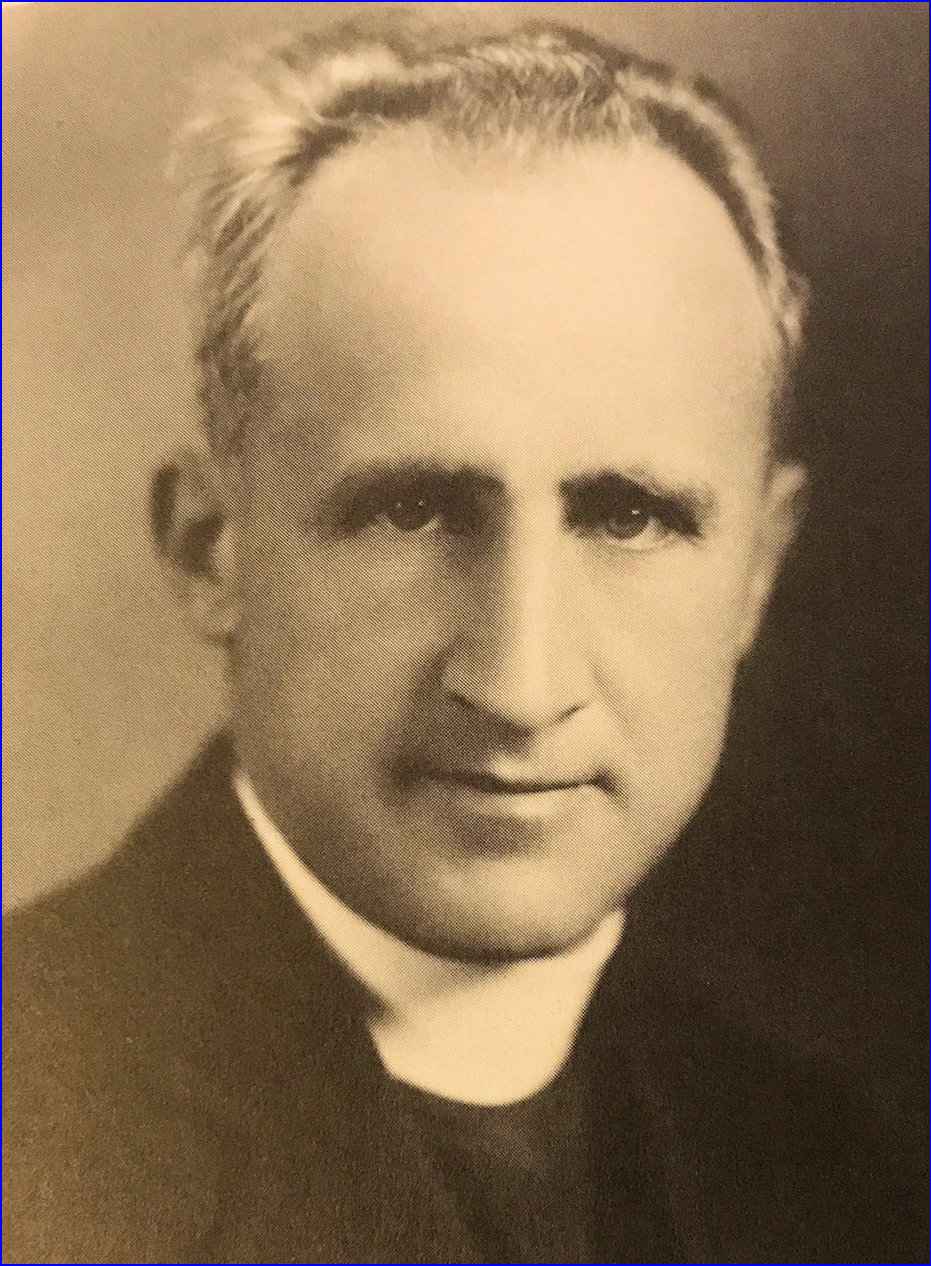
Born the 3rd of October, 1886 in Kenosha, Fr. Kimball saw through the building and opening of St. Francis House at 1001 University Ave. Educated at Racine college in Wisconsin and Trinity college in Hartford, Connecticut as well as the University of Wisconsin, he took his theological education at Oxford university, England and the General Theological Seminary in New York. According to his obituary he worked in the electrical business in Buffalo, New York for several years before entering the ministry as a curate of St. Paul’s in Milwaukee before World War One, into which he went as a chaplain. Following the war he served as rector of St. Andrew’s in Madison for five years before replacing the Rev. Cleveland in 1925.
The Rev. Kimball was a musician, playing piano and violin “with more than ordinary ability.” He spent summer months abroad in France studying music and in Madison he played with the Civic Symphony as well as singing in various choirs and organizing concerts. He was a personal friend of the violin virtuoso Paul Kochanski.
His death at age 44, coming just a year after St. Francis House was opened, was headline news in both major Madison papers. He was killed near Pewaukee, Wisconsin when, driving in a blizzard, his car stalled. Crossing the road to a telephone he was hit by a driver blinded by the blowing snow. Many tributes appeared in the following weeks and months. He never married.

The Rev. Alden Drew Kelley (1903-1980);
Chaplain 1931-1939
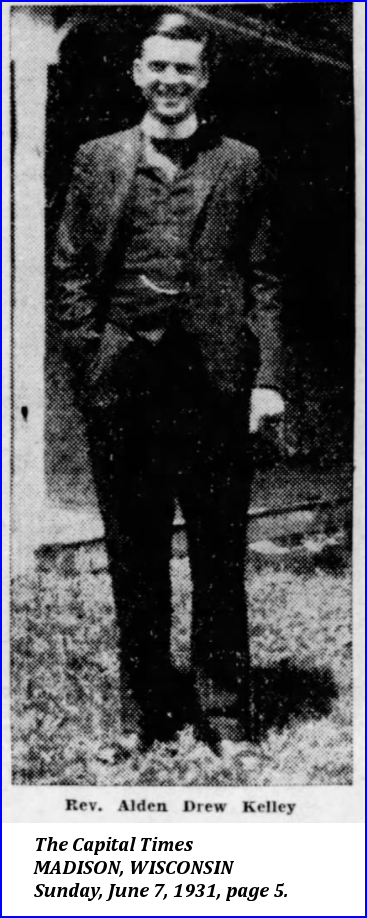
Twenty-eight-year-old Alden Kelley was an instructor at Nashotah house when he accepted the job as the Rev. Kimball’s replacement in June of 1931, beating out 12 to 15 other applicants for the job. Reverends L.B. Lumpkin and Francis Bloodgood, of Grace and St. Andrew’s had filled in for several months. A graduate of Tufts University, Boston University and the General Theological Seminary and newly married in September of 1930, the young couple settled into a house on Paunack Place, a twenty-minute walk down University Ave. from St. Francis House. Their son, Alden junior, was born the October after he took the job.
Kelley, whose name is often misspelled “Kelly,” left in April of 1939 for New York City to become secretary of college work on the National Council of the Episcopal Church, a job he held for five years before being named Dean of Seabury-Western Seminary in Evanston, Illinois in 1944. That position he held until January of 1956 when he resigned. The Kelley’s moved to England where he became subwarden of St. Augustine’s College, Canterbury. Upon returning to America, he served on the faculty of Bexley Hall, the Seminary associated with Kenyon College in Gambier, Ohio.
A rather prolific writer, there are 12 works in 22 publications through his career including at least 8 books from 1934 to 1969. See his works at Worldcat Identities. He died April 18, 1980 in Mt. Vernon, Ohio. His wife Edna, née West, died ten years later, also in Ohio. They are buried together Kenyon College Cemetery in Gambier with their son who died in 1996.

The Rev. Charles Francis Boynton (1906-1999);
Chaplain 1939-1942

The son of a professor at General Theological Seminary, 33-year-old the Rev. Boynton accepted the call to St. Francis House in April of 1939 and moved into a house at 28 Lathrop by June with his wife Helen née Fowler and their two children, six-year-old Carol and four-year-old Frederic. They had married in 1934 in Bronxville, New York, his father a co-officiant.
He remained only two and a half years, resigning effective January 1, 1942 when he accepted a post in Puerto Rico where he became diocesan bishop in 1947. In January of 1951, this native of Geneseo, New York, became Suffragan Bishop of the Diocese of New York, a post he served until 1969, the year his wife Helen died.
In retirement, Bishop Boynton did not like the course that the Episcopal Church was taking, leaving in January of 1990 for the Anglican Catholic church with this statement: "After the House of Bishops meeting this fall in Philadelphia, it is clear that the Episcopal Synod of America interests continue to be under the mandate of General Convention and the Constitution and Canons of the Episcopal Church, along with its heretical theology, questionable morality, and increasingly secular and liberal approach to just about everything."
Born in 1906, he was educated at Williams College and the General Theological Seminary, and died in Spartanburg, South Carolina on July 3, 1999. His obituary in The Living Church, and his Wikipedia article both have that he remarried Dori Watson, but do not include that he had both a son and a daughter by his first wife.

The Rev. Gordon Edward Gillett (1911-1986);
Chaplain 1942-1944

The appointment of Fr. Gillett was announced in January of 1942. A native of Somerville, Massachusetts, he came to Madison four years a priest and at age 31 from a ministry to students at the University of Maine attached to St. James’ in Old Town, Maine. He had been ordained in 1938 after being educated at Bowdoin College, Columbia University, Union Theological seminary and Virginia Theological Seminary.
Shortly after he left Madison in the spring of 1944 to become Director of Youth Work on Long Island, he married in Milwaukee that August, Miss Katherine Black whom he had met in Madison. About 1949 they relocated to Peoria, Illinois where he served St. Paul’s Church for 20 years. They returned to New England about 1970 where he retired in 1976 after serving Christ Church, Portsmouth, New Hampshire. The Rev. Gillett and his wife Katherine are buried together at Christ Church Memorial Garden in Portsmouth, New Hampshire. They had no known children.
Chaplains continued through Fr. White (1964)
The Rev. Daniel Corrigan (1900-1994);
Chaplain 1944
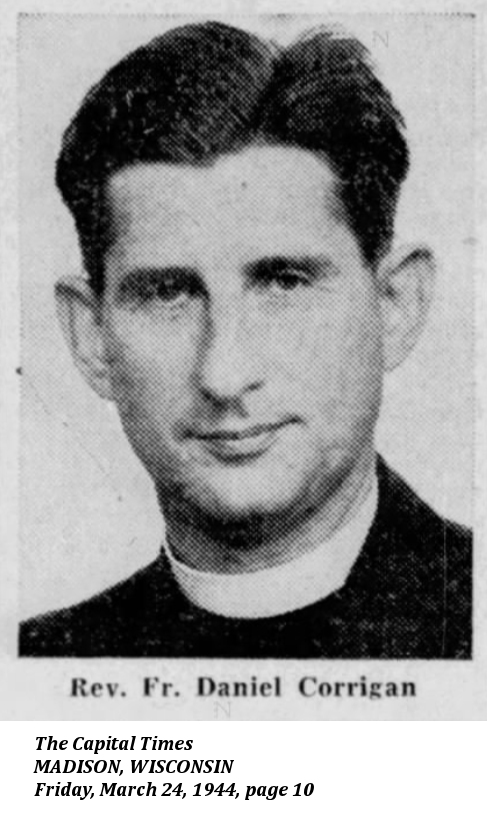
Perhaps one of the shortest chaplaincies in the war years was that of the Rev. Daniel Corrigan. At age 44 he replaced Rev. Gillett in the spring of 1944 and left in December to become rector of Grace and St. Peter’s in Baltimore. His life and career were perhaps among the most controversial of all of the St. Francis House chaplains. While his biography in the Episcopal Dictionary of the Church is quite complete, it does not point out, as does his obituary in the New York Times, that he demonstrated against the war in Vietnam, marched with the Rev. Martin Luther King Jr. on Washington and sat with him when he delivered his “I have a dream” speech in 1963.
Fr. Corrigan’s biography as in the Episcopal Church’s online dictionary of the Church: (Oct. 25, 1900-Sept. 21, 1994): One of three bishops who first ordained women. He was born in Rochester, Minnesota, and received his B.D. from Nashotah House in 1925. He was ordained deacon on June 1, 1924, and priest on May 21, 1925. He was rector of St. John the Baptist Church, Portage, Wisconsin, 1925-1931; Zion Church, Oconomowoc, Wisconsin, 1931-1944; Grace and St. Peter's Church, Baltimore; and St. Paul's Church, St. Paul, Minnesota. He was consecrated Suffragan Bishop of Colorado on May 1, 1958. He resigned on June 1, 1960, to become director of the Home Department of the Executive Council of the Episcopal Church, where he served until 1968. In 1969-1970 he was acting dean of Bexley Hall. Corrigan was one of three bishops who ordained eleven women to the priesthood on July 29, 1974, two years before General Convention voted to ordain women to the priesthood. He was known as an advocate for peace and human rights. He demonstrated against the Vietnam War and participated in AIDS ministry in Los Angeles. He died in Santa Barbara, California.
He returned to Madison in 1979 to preach at St. Francis House on its 50th anniversary. Married in 1926 to Elizabeth Waters, he was survived by four sons, 18 grandchildren, and nine great-grandchildren.

The Rev. Carroll E. Simcox (1912-2002);
Chaplain 1945-1949
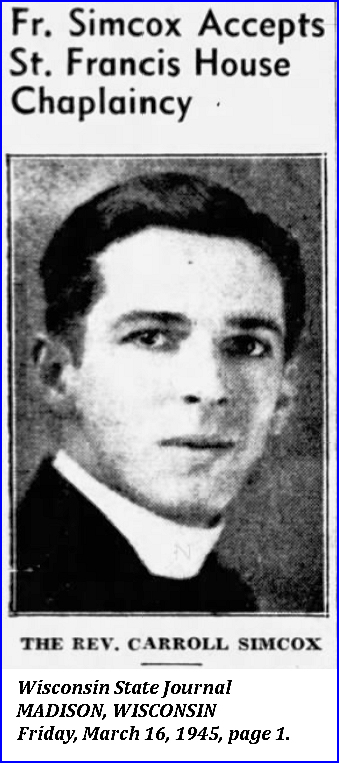
Fr. Carroll Eugene Simcox was thirty-three when he accepted the call to St. Francis House in March of 1945 to become chaplain. He came from a three-year chaplaincy at the University of Illinois. Born in Lisbon, North Dakota in 1912, He had married Georgiana née Mantor in Minnesota in December of 1939. With him to Madison in August came his wife “Jessie,” a five-year-old son and a three-year-old daughter. He was educated at the University of North Dakota, Oberlin (B.D. 1936), Seabury-Western seminary, and had been working on a Ph.D. in classics at Illinois. Prior to his years at Illinois, he had served parishes in Appleton and Owatonna, both in Minnesota.
Leaving Madison in 1949, the paper says he was to take up a post at Canterbury college in Danville, an ill-fated college at that time, but rather he served Zion Episcopal church in Manchester, Vermont from 1950-1955, then assistant at St. Thomas in New York City for two years, followed by five years at St. Mary’s in Tampa, Florida, which he left to become editor of The Living Church in Milwaukee. The Episcopal Church saw major changes during the years he was editor, and he did not like them. He renounced his ministry in the Episcopal Church in 1980 writing that The position to which I have unhappily come is that I can no longer worship joyfully and serve whole-heartedly in this Church as it has become liturgically, doctrinally, and morally. I cannot believe that it is the duty, or even the right, of a Christian to remain in a church body about which, if he is honest, he must say what I have just said."
A fervent traditionalist, he continued to preach and took up an Anglican Catholic Church, St. Barnabas, in Atlanta and held the post of archdeacon of the Anglican Diocese of Eastern United States.
Always a prolific writer his Worldcat Identities lists 44 works in 108 publications. It began early with letters that appear in the Minneapolis papers arguing back and forth in the letter columns when he was a pastor in Appleton, Minnesota. Fr. Simcox sucumbed in 2002 to Parkinson's discease in St. Petersbury, Florida, survived by his two children. He is buried with his wife "Jessie" who died three years earlier.

The Rev. Gerald White (1900-1969);
Chaplain 1949-1964
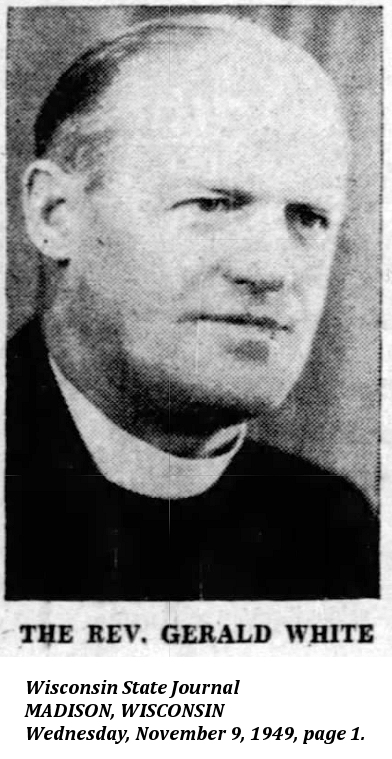
Forty-nine-year-old Fr. White served as acting chaplain after Simcox left in March of 1949 and was named permanent chaplain in November of that year. A native of Newfoundland, when he was 18, in 1918, his father became the Anglican Bishop of Newfoundland. He was the middle child of the Rt. Rev William Charles White and his wife Frederica and had sisters Dorothy and Elizabeth.
On a path to follow in his father's footsteps he attended Kings College in Nova Scotia, went to Oxford University on a Rhodes Scholarship in 1922 and was ordained in 1927. Following three years as a pastor in Manchester, England, he went to Racine, Wisconsin to become the chaplain of the Racine Military academy, St. Luke's hospital and the Taylor orphanage in Racine. In 1934 he became the headmaster of King's-Edgehill School in Windsor, Nova Scotia. His father, the bishop, died in 1943 and Gerald became the canon residentiary the Diocese of Eastern Newfoundland and Labrador that year. In 1948 he returned to Wisconsin where he became chaplain the following year after he married in Madison Miss Adalin Brown, who died in 1950. He retired in June of 1964 and died five years later at his home in Madison.
Footnotes: Note:links to newspapers.com images need a subscription.
Footnotes:
About me
For four academic years between 1963 and 1967 I lived on the top floor of St. Francis House. My brother, Jim, was there for three years before me. We were “houseboys.” Those were turbulent times. In 1967 the one-way bus lane was put down University Ave and the SDS held a rally in front of the House to protest government – whether it was in Madison or Washington. It was only the beginning. After 2 ½ years doing graduate work and beginning my draft requirement work at Goodwill, Fr. Lloyd invited me to work as a program director at SFH, a post I gladly accepted to complete my CO work.
We attended the Special Convention of the Church in South Bend in 1969 and the Houston Convention the next year. During the campus riots of May, 1970 following the invasion of Cambodia, SFH was one of two “safe houses” on campus – the WSJ reported that about 20 students at the House were treated for tear gas effects. I just remember the lounge full of kids escaping to safety. With SFH fellow, the late Charley Taylor, we operated a draft counselling office in the basement, no doubt monitored by the FBI, as were our anti-war activities at the conventions. Following my CO work, I worked for a time as a grants officer for the Church visiting anti-war and community organizations. Returning to Madison in 1973 I was involved with Broom Street theater which rehearsed and performed at SFH from 1970 to 1975. I was married in the “new” chapel in 1974. Now, in 2021 ten years after the death of my wife and retired, I research and publish online history articles. I got curious about SFH after seeing varying dates for its construction and fell down this rabbit hole. I want to thank Bill Mueller for the pictures he took of the move of the house in 2012 and Allan Deptula for encouraging me to do this research.
Page created August, 2021, Updated September, 2021.
© Text copyright: Steve Spicer
Feel free contact me about this page.
